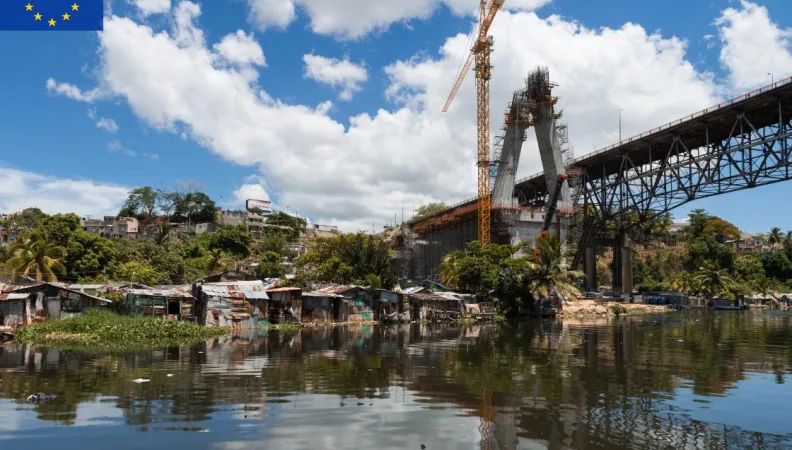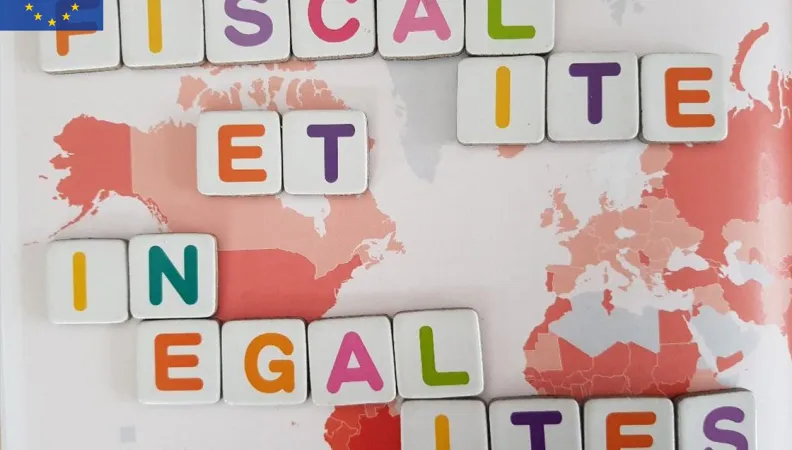Dakar, Sénégal
Dakar
Sénégal
 Legal notice EU (project) AFD, AECID and Oxfam are committed to reverse rising inequality in order to reduce poverty in a significant and lasting manner through a human right approach. The research process will conduct a regional analysis, in west Africa and Central America, of the multidimensional inequality based on an innovative inequality framework which is being developed by Oxfam. The study will focus as well on the impact on inequality of a sample of public policies implemented in the regions in the last decade.
Legal notice EU (project) AFD, AECID and Oxfam are committed to reverse rising inequality in order to reduce poverty in a significant and lasting manner through a human right approach. The research process will conduct a regional analysis, in west Africa and Central America, of the multidimensional inequality based on an innovative inequality framework which is being developed by Oxfam. The study will focus as well on the impact on inequality of a sample of public policies implemented in the regions in the last decade.
Contexte
The world has seen a significant reduction in the extreme poverty levels in the past decades, led by strong economic growth from emerging economies. Despite the economic growth, the incomes of the poorest people all over the world are not keeping up. Eight out of ten people in developing countries live in nations where the income of the bottom 40% has grown slower than the rest of the economy (Hoy & Samman, 2015) and 7 out of 10 people live in a country where inequality has risen in the last 30 years.
Regarding Latin American and the Caribbean, although the region achieved considerable success in reducing extreme poverty over the last decade, its still-high levels of income and wealth inequality have damaged sustainable growth and social inclusion.
In West Africa, the sub-region had the largest average economic growth at 6.2 percent between 2010 and 2014 among Africa's regions, and compared with 4.4 percent for Africa during the period. However, there is growing concern that the benefits of this impressive growth have not been inclusive and equitably shared. The combination of high economic growth and stubbornly high income inequality rates remains a puzzle.
This project is part of a European facility for a research program on inequalities in developing and emerging countries which is coordinated by the AFD. Financed by the Development Cooperation Instrument of the European Union, this facility enables to implement 20 research projects over the period 2017-2020, in partnership with donors and research centers from the South to the North.
This project is part of the first phase of the Research Facility on Inequalities, coordinated by AFD and funded by the European Commission's Directorate-General for International Partnerships over the 2017-2020 period. The first phase of the Facility has led to the conduct of 22 research projects and the publication of around 100 research papers and policy briefs.
Objectif
Even if we know less unequal societies are desirable given their beneficial economic, social and political outcomes, there is still uncertainty on which are the best routes to understand and tackle inequalities through a multidimensional perspective. To contribute to this global conversation on inequalities, Oxfam, the International Inequalities Institute at the London School of Economics and the School of Oriental and African Studies of the University of London, are joining efforts to develop a conceptual and measurement framework on inequalities. The purpose of the framework is to provide analysts and practitioners with a theoretically-grounded means by which to gain a clear understanding of the nature of inequality and to use this information to develop and devise effective policy responses with the long-term goal of reducing inequalities, tackling deprivation and improving well-being.
Méthode
The framework is designed to capture the multidimensional nature of inequality, which is experienced across a number of 7 life domains, and given that there are many different forms of inequality (such as concentrations of wealth, pay gaps, dispersion of income, social gradients in mortality, and greater social isolation experienced by the elderly). The framework is based on Amartya Sen's capability approach. The focus of this approach is an assessment on what life we lead and what we can or cannot do, and can or cannot be; the quality of life that individuals are able to achieve. Equally important, this framework should enlighten the discussion on inequalities in a way that allows for context-specific diagnosis and policy recommendations, so that it can support the strategic work of practitioners and key stakeholders of the development arena.
See this project's 2 minutes pitch from Ana Claver, Project Manager on Inequalities at Oxfam Intermón:
Résultats
Evidence from more than 150 countries, rich and poor alike, spanning more than 30 years, shows that overall, investment in health, education and social protection reduces inequality. Nevertheless, we still need to know more about what are the concrete mechanisms that make these inequality reductions happen, and how certain policies should be designed so that they tackle spatial, gender and ethnic inequalities in an effective manner. We expect to draw lessons from those different scenarios by this comparative research.
The researchers involved in this project anticipate that active citizenship is a means to achieve development, because it enables women and men living in poverty to raise their voice in defence of their rights (health, education, jobs, dignity). Moreover, they presuppose that public policies amplify their effectiveness when citizens are involved in their cycle. They also presume that women and girls plus youth are the groups especially impacted by multidimensional inequality and thus, they should be carefully considered in the research.
Find the presentation of the research paper "Multidimensional inequality in Western Africa" by Ana Claver Muñoz and Cristina Rovira Izquierdo, project manager on inequalities and inequality programme advisor at Oxfam Intermón during the fifth webinar of the Research Facility on Inequalities:
You may find the deliverables linked to this project here:
West Africa Report:
- Analysis of multidimensional inequalities in West Africa and a strategy for inequality reduction (in English)
Central America and Dominican Republic Report:
- Analysis of multidimensional inequalities in Central America and Dominican Republic, and a strategy for inequality reduction (in English)
Policy briefs:
- A strategy for reducing inequalities in West Africa (in English)
- A strategy for reducing inequalities in Central America and the Dominican Republic (in English)
You may also find a short presentation video of the Multidimension Inequality Framework (MIF) used in this research project (in English):
Contact:
Anda David, Research Officer, AFD
 Legal notice EU (project) Via their tax component and their component of transfers and public expenditure, budget policies are a crucial instrument for governments in their fight against inequalities. This research project seeks to improve understanding of the relationship between income inequalities and these budget policies in developing countries.
Legal notice EU (project) Via their tax component and their component of transfers and public expenditure, budget policies are a crucial instrument for governments in their fight against inequalities. This research project seeks to improve understanding of the relationship between income inequalities and these budget policies in developing countries.
Context
Reduction of inequality is one of the core Sustainable Development Goals (SDGs). One of the targets of SDG 10 is for income growth of a country’s poorest 40% to be higher than the national average. Reaching this objective requires setting up economic policies on public expenditures and taxes that will benefit the poorest people. At the same time, mobilizing tax revenue can play a key role in financing the SDGs, but it is important to understand under what conditions this higher level of tax revenue collection is reconcilable with the goal of reducing inequalities.
This project is part of the first phase of the Research Facility on Inequalities, coordinated by AFD and funded by the European Commission's Directorate-General for International Partnerships over the 2017-2020 period. The first phase of the Facility has led to the conduct of 22 research projects and the publication of around 100 research papers and policy briefs.
Goal
This research project seeks to improve understanding of the relationship between income inequality and budget policies in developing countries. The study is divided into three parts:
- Investigation into the redistributive impact of taxes, transfers, and public expenditure in three countries of West Africa (Côte d’Ivoire, Mali, and Senegal). The analysis will try to answer the following questions:
- Who pays taxes, and who benefits from the transfers and public expenditures?
-
What is the overall impact of the tax and transfer systems on inequalities?
-
What tax instrument can mobilize revenues while reducing poverty and inequality?
- Study of the effect on inequalities from applying different types of taxes in the developing countries. Is the increase in tax revenues (measured by the ratio between revenue and GDP) linked to a reduction or an increase in inequalities? The relationship between the type of taxes levied and the change in inequalities within a country and between different countries will be studied in order to identify which taxes are progressive or regressive.
- Analysis of tax compliance behaviors in Africa, by identifying how the level of inequalities affects citizens’ attitude towards taxes.
Method
This research project will use econometric quantitative studies based on household survey data and macro-economic data available on a large number of countries (Parts 2 and 3). Microsimulation tools will also be used (Part 1).
Results
You may find the research papers and the policy briefs here :
Research papers:
- Fiscal consolidation and health inequality: Evidence from infant mortality in Sub-Saharan Africa
- Collect more, spend better? Assessing the incidence of fiscal systems and public spending in three francophone West African countries
- Inequality in the public good provision and attitude towards taxation: sub-national evidence from Africa
Policy briefs:
- Collect more, spend better? Enhancing fiscal redistribution in West Africa
- Fiscal consolidation in Sub-Saharan Africa: Unequal effects on children’s health
- Building fiscal capacity in Sub-Saharan Africa: The role of local inequality
- Measuring local inequality: Insights from data on night lights
Find also the presentation of the research paper "Inequality in the public good provision and attitude towards taxation: sub-national evidence from Africa" by Marin Ferry, Senior Lecturer at Gustave Eiffel University / Associate Researcher IRD-DIAL during the fourth webinar of the Research Facility on Inequalities:
Contact: Hélène Ehrhart, Economist, AFD
